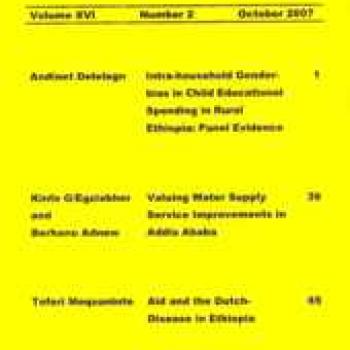
The paper uses data from a 2002 survey of 1000 rural and urban households with eight-year old children sampled from food insecure communities in Tigray, Amhara, Oromia, SNNP and Addis Ababa Regional States. Using a probit regression model, we investigated external factors associated with child enrolment in school. We found that household wealth, cognitive social capital, adult education and ownership of land had a positive impact on whether eight-year-old children were attending school. Household wealth had the strongest impact followed by cognitive social capital (perceived levels of trust and reciprocity), the maximum level of education attained by female adults in the household, ownership or rental of land, and the maximum level of education attained by male adults in the household. In contrast, child enrolment was found to be negatively associated with the number of household members over the age of 15 years, birth order, ownership of livestock, economic shocks, distance to primary school, and child labour, in declining magnitude. The findings in general suggest that increasing child enrolment in primary school, which is a commitment of the Sustainable Development and Poverty Reduction Program (SDPRP) and Education Sector Development Program (ESDP), will necessitate more targeted educational policies to address regional, gender and wealth disparities, the development of education programmes for adult caregivers, as well as broader inter-sectoral policy initiatives to ensure that policy initiatives in other sectors facilitate rather than hinder children?s education (particularly credit and labour markets and infrastructure-related policies).

The paper uses data from a 2002 survey of 1000 rural and urban households with eight-year old children sampled from food insecure communities in Tigray, Amhara, Oromia, SNNP and Addis Ababa Regional States. Using a probit regression model, we investigated external factors associated with child enrolment in school. We found that household wealth, cognitive social capital, adult education and ownership of land had a positive impact on whether eight-year-old children were attending school. Household wealth had the strongest impact followed by cognitive social capital (perceived levels of trust and reciprocity), the maximum level of education attained by female adults in the household, ownership or rental of land, and the maximum level of education attained by male adults in the household. In contrast, child enrolment was found to be negatively associated with the number of household members over the age of 15 years, birth order, ownership of livestock, economic shocks, distance to primary school, and child labour, in declining magnitude. The findings in general suggest that increasing child enrolment in primary school, which is a commitment of the Sustainable Development and Poverty Reduction Program (SDPRP) and Education Sector Development Program (ESDP), will necessitate more targeted educational policies to address regional, gender and wealth disparities, the development of education programmes for adult caregivers, as well as broader inter-sectoral policy initiatives to ensure that policy initiatives in other sectors facilitate rather than hinder children?s education (particularly credit and labour markets and infrastructure-related policies).

